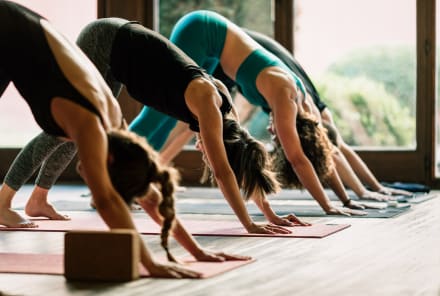Advertisement

Yoga teachers have a language all their own, and I'm not talking about Sanskrit. I'm talking about those other foreign things we hear throughout our Hatha yoga practice. Phrases such as find your center, root yourself, become present, listen to your breath, and set your intention.
I had practiced yoga for years, under many different and amazing teachers, who'd instruct me to do these things, but neglected to tell me how.
Please, do not misunderstand, had I asked, I am sure any of my excellent teachers would have been happy to explain, but I was too shy or embarrassed to present the question.
As a yoga newbie, these phrases can leave us feeling left out, as if we do not know the secret handshake to an ancient tribe. We have all been here at sometime or another. Perhaps it was your first yoga class, a teacher who you never met that focused more on the spiritual of the eight limbs, or maybe you are contemplating beginning a yoga practice but are concerned you will not know the “handshake.”
For me, it was not until I entered Yoga Teacher Training that I had the courage to ask “what does that mean?” I hope to alleviate some pressure here by offering what some common yogic terms have taught me.
1. Find your center.
Finding your center means to connect with your spirit. Allow yourself to dwell on your innate goodness. Your center is that intangible place located within your core that is the best you possible. It reassures you to trust your intuition, that you are safe for your purpose within this universe, and for some, it may be where you connect to your higher power or God. Your center is a safe place that is always available to you and offers renewal and refreshment.
2. Root yourself.
In my practice, “rooting” means to connect with my root chakra or Muladhara. When this first chakra, located at the base of the spine, is open, one attains an emotional and physical state that is supported by the positive energies of the universe, allowing a deep and safe connection with ones self and environment. Bringing this chakra into balance allows for trust, resourcefulness, and courage. A few recommend yoga poses for balancing the Muladhara include, Tadasana (Mountain Pose), Virabhadrasana 1 (Warrior One), and Setu Bhandasana (Bridge Pose).
3. Become present.
This term means to clear your thoughts of all outside concerns and be focused on what you are doing at the moment. In our fast paced, multi-tasking lives, being present in the moment can be difficult. While you are practicing yoga, allow yourself to truly be practicing yoga.
Listen to your breath, your body, and your intuition. Being present in the moment is simple, but it is not easy. With time and practice, one can learn to be present in all moments, allowing for mindfulness and consciousness in every situation.
4. Listen to your breath.
This phrase means just what it says. Since our first moment on earth we have been breathing, it is a natural instinct not often thought of. When practicing yoga, we become conscious of breath, noticing how each movement is supported by our inhale and exhale.
Breath can bring you forward and deeper into your pose. It can also tell you when you are working too hard or when you are feeling good. Get to know your precious breath, take care of it, and allow it to remind you of all that it carries you through.
5. Set your intention.
This is a term that, for years, I truly had no idea of it's meaning, and yet, I heard it in nearly every yoga class. What I have learned through personal study, is that setting your intention is quite different from person to person and even moment to moment.
One class my intention might be to focus on strength, breathing, flexibility, or to try a new pose. Another day my intention might be to care for myself, open a chakra, honor my body, or be present in the moment. But most often, I find my intentions are sent outward.
As I teach a class, I will often suggest an intention for the positive energy created by the group to be sent to a place going through a perceptually negative time, perhaps the less fortunate in your community, or something big happening in the news. Intention feels somewhat like a prayer, dedication, hope, or wish. By practicing intention in yoga, we learn to live a more intentional life, thus allowing us to live to our full potential.
While these terms can be useful, above all, listen to your body and spirit, take care of yourself and others.
Watch Next
Enjoy some of our favorite clips from classes
Enjoy some of our favorite clips from classes
What Is Meditation?
Mindfulness/Spirituality | Light Watkins
Box Breathing
Mindfulness/Spirituality | Gwen Dittmar
What Breathwork Can Address
Mindfulness/Spirituality | Gwen Dittmar
The 8 Limbs of Yoga - What is Asana?
Yoga | Caley Alyssa
Two Standing Postures to Open Up Tight Hips
Yoga | Caley Alyssa
How Plants Can Optimize Athletic Performance
Nutrition | Rich Roll
What to Eat Before a Workout
Nutrition | Rich Roll
How Ayurveda Helps Us Navigate Modern Life
Nutrition | Sahara Rose
Messages About Love & Relationships
Love & Relationships | Esther Perel
Love Languages
Love & Relationships | Esther Perel












